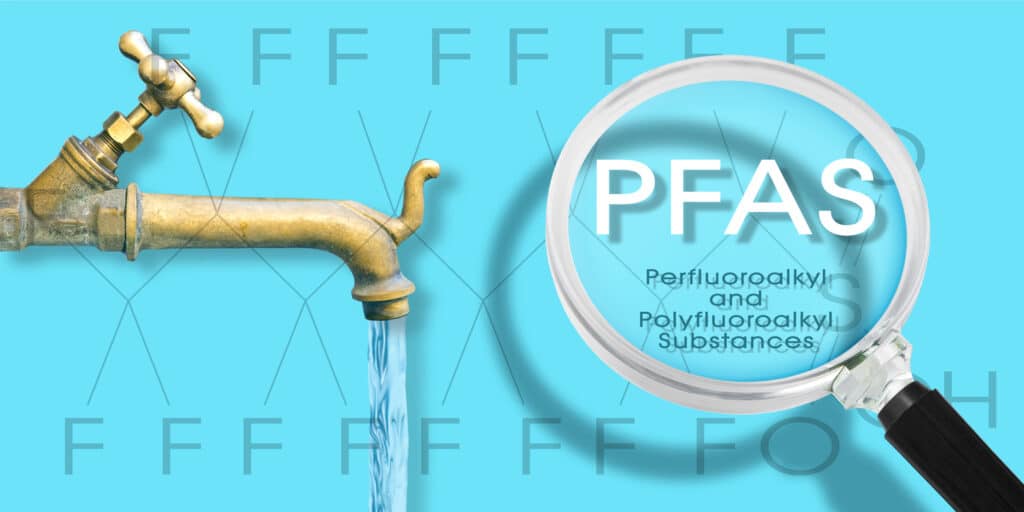Perfluoroalkyl and polyfluoroalkyl substances — better known as PFAS — are man-made chemicals which include PFOA and PFOS. As carbon and fluorine form strong and stable bonds, these toxic chemicals are extremely hard to break down therefore, can linger in the air, water, and our bodies for long periods of time. With the ability to travel through air, dust, food, soil, and water, PFAS can travel great distances making it even tougher to remove. Being heat, grease, stains, and water-resistant, PFAS are commonly found in food packaging, carpets, rainwear, cleaning products, non-stick cookware, and firefighting foams. In fact, the Department of Defense has uncovered minute amounts of PFOS and PFOA in at least 400 active or closed military bases. The chemicals then leaked into the groundwater. Based on a test conducted in 2007 by the US Centers for Disease Control and Prevention, it revealed that approximately 98 percent of Americans have PFAS in their bloodstream. The contaminant can be found in our blood, kidney, and liver. According to the CDC, regardless of whether we inhale or drink PFAS, it would take a maximum of five years for its level to reduce by 50 percent.
Multiple states across the country are battling against “forever chemicals,” California is just one of the many. According to water samples collected by the
Environmental Working Group throughout 2013 to 2019, traces of the contaminants could be found in water sources which caters to an upward of 7 million Californians. EWG concluded that 40 percent of the sources contained at least one water sample that exceeded the advisory limit of 0.07 parts per billion (ppb) of PFAS. While not a legal limit, the non-enforceable lifetime health advisory released by the Environmental Protection Agency (EPA) is meant to be a warning to state officials that the elevated levels of PFAS could affect human health. PFAS could lead to heightened cholesterol levels, immune system related issues, thyroid problems, and possibly cancer.
Recognizing the danger of PFOS and PFOA, the US has prohibited the two chemicals. The EPA also plans to legally regulate the PFOA and PFAS in the upcoming two years, while certain states such as California are looking to implement their own regulations and bans. Beginning in 2020, California would mandate that utilities inform customers if any amount of PFAS is discovered. The water systems would also be forced to close wells that exceed the advisory limit. Since May 2019, 180 countries have agreed to prohibit the production and usage of PFOA. However, as PFOA and PFOS is just one of the thousands of PFAS chemicals being used, it is not enough to simply set limits on just two contaminants.
While we are unable to remove the PFAS in your food packaging or in common household products, our
Kinetico K5 Drinking Water Station is
certified to remove PFOS and PFOA from your water. In fact, with the addition of our optional auxiliary filters, our Kinetico solution can remove more contaminants than any other system on the market. Thanks to our reverse osmosis system, you can enjoy 40 gallons of the best-quality and best-tasting drinking water. Give us a call now at 408 371 5521 or visit our
website to book a free onsite water consultation now!
References
- ABC7, “Report: 74 California Water Systems Contaminated, 7.5 Million Potential Exposed to Toxic
- Chemicals,” 2019, https://abc7news.com/amp/health/report-75-million-californians-potentially-exposed-to-toxic-chemicals-in-water/5570341/
- Anna M. Phillips and Anthony Pesce, “California finds widespread water contamination of ‘forever chemicals’,” Los Angeles Times, 2019, https://www.latimes.com/politics/story/2019-10-10/california-finds-widespread-contamination-of-chemicals
- Aria Bendix, “A scientist who worked at a company that’s being sued over dumping ‘forever chemicals’ warns the toxins ‘stay in your blood and don’t leave’,” Business Insider, 2019, businessinsider.com/pfas-chemicals-linger-in-blood-dupont-scientist-2019-7
- Elena Nicolaou, “The Story Behind Dark Waters Affects You,” Refiner29, 2019, https://www.refinery29.com/en-us/2019/11/8801601/dark-waters-true-story-dupont-chemical-spill-lawyer
- Kevin Loria, “Should you be concerned about PFAS chemicals,” Consumer Reports, 2019, https://www.consumerreports.org/toxic-chemicals-substances/pfas-chemicals-should-you-be-concerned/
- Lauren Zanolli, “Why you need to know about PFAS, the chemicals in pizza boxes and rainwear, The Guardian, 2019, https://www.theguardian.com/us-news/2019/may/23/pfas-everyday-products-toxics-guide
- Leah Asmelash, “Drinking water serving 7.5 million Californians has been contaminated with toxic PFAS, new report says,” CNN, 2019, https://www.cnn.com/2019/09/27/us/pfas-california-contamination-trnd/index.html
- Nadia Kounang, “What are PFAS chemicals, and what are they doing to our health?” CNN, 2019, https://www.cnn.com/2019/02/14/health/what-are-pfas-chemicals/index.html



